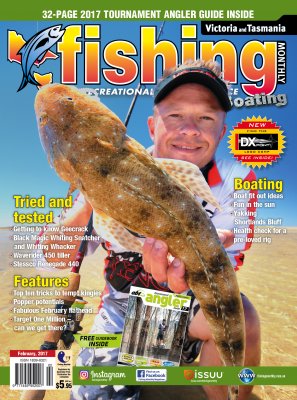10 tricks to tempt tenacious kingies by Mark Gercovich
 There are many reasons why some fish are popular angling species: some taste good, some look good, some fight hard, some are hard to find, or some require specific angling dedication. However, the yellowtail kingfish is one of my favourite targets because they fit all those criteria...and some more!
There are many reasons why some fish are popular angling species: some taste good, some look good, some fight hard, some are hard to find, or some require specific angling dedication. However, the yellowtail kingfish is one of my favourite targets because they fit all those criteria...and some more!
Kingfish are renowned for being temperamental, at times fickle, whereas other times they eat ravenously. They respond to a variety of techniques. Depending on their mood, you'll need to have multiple options ready for the day, which adds to the challenge and intrigue of kingy fishing. Here are 10 ways to tempt a kingfish.
POPPERS
Surface fishing for any species is addictive, doubly so when it comes to kingfish. Having a metre-plus king engulf a popper off the surface is always worth the many casts it can take to happen. The combination of bubble and splash usually gathers the attention of the cruising kings and triggers an aggressive response.
Poppers work when cast to sighted schools but have the added ability to draw unseen fish from a distance or the depths, as opposed to other surface lure techniques. Poppers can also work when trolled behind the boat, as long as the lure is worked by the angler and not just left in the holder.
STICKBAITS
Rather than being a big searching/attracting style lure like a popper, stickbaits are perfect lures for offering to a school that is shy of an aggressive retrieve/approach.
Quality stickbaits that cast and swim well are essential to attract a kingy. Also, a stickbait that sinks horizontally on the pause in a burn and kill retrieve can sometimes work well to fire up inquisitive, but non-committal kings.
The natural finish is also important when a king has the opportunity to eyeball the lure that is paused in front of them. The longer the cast, the longer the retrieve, the more time a fish has to intercept it. There's nothing worse than running out of room as a speeding pelagic veers away at the last minute as your lure reaches the boat before they catch up to it. Likewise, the closer you get the boat to the fish when casting, the more likely you are to spook the school. A stickbait that casts a long way is a huge help to your success.
TROLLED STRIP BAITS
As with most species of pelagic fish, trolling is a popular way of targeting kingfish. The major advantage of trolling is that you cover lots of ground. Kingies can move around a lot and trolling keeps you on the move and actively looking for them.
Small skirted lures, in combination with strip baits, are a successful way of enticing a king to bite when trolling. The skirt helps keep the strip bait from spinning, as well as providing a bit of extra flash and bubble. Teasers can be employed to assist with this flash and bubble, however, you'll need to have plenty of help on board to clear the teasers and other trolling lines, particularly if big fish are involved.
The smell of the fresh strip bait behind the bubble and flash of the skirt is the clincher of the deal. A fresh strip is a crucial part of the equation; there is no use having the best spread in the world at the back of the boat if the fish are fussy and demanding fresh bait.
Fresh squid strips are a well-known, and frequently used strip trolling bait. Strips of snook and salmon are also good as they are often a freshly caught by-catch of a trolling operation. Make sure they are long and thin and don't spin when trolled through the water.
SOFT PLASTIC SLUGS
Another productive trolling technique is to troll sluggo style soft plastics. Trolled at a speed where the lures are skipping on the surface, can be a deadly technique that doesn't involve the need for fresh bait.
Pre-rigged sluggos are a great advantage as they track well in the water reducing the need for fastidiously straight hook placement. Not only do these lures work well on the troll but are also an effective lure when cast. They are best worked quickly across the surface to mimic a fleeing garfish. The cast slug sits between the popper and stickbait, offering a combination of drawing power with its splash but a bit more subtlety than a popper.
JIGS
Jigging is a well-known technique for catching kings in deeper waters say 20-40m deep. Whilst we occasionally get kings we have spotted schooled up deep, most of our jig caught kings come from schools that were originally spotted on the surface and then for whatever reason sounded to the depths. Keeping an eye on the sounder and having a jig rod ready though can make a seemingly missed opportunity a hook up.
TROLL LIVE BAITS
A live bait trolled silently out the back behind an electric motor is a great way of covering the ground in search of a king. Popular livebaits can include squid, salmon, tommy ruff and trevally. For deep water, just add a downrigger to the equation.
At the front of the boat, anglers can cast large surface lures in the hope of enticing a king. One of the other benefits of this technique is the ability to give chase quickly whenever a large fish is hooked. Not being at anchor, you have the freedom to be able to move off after the fish.
Try and always keep the least amount of line between you and the fish and the front of the boat pointing towards the direction the fish is heading.